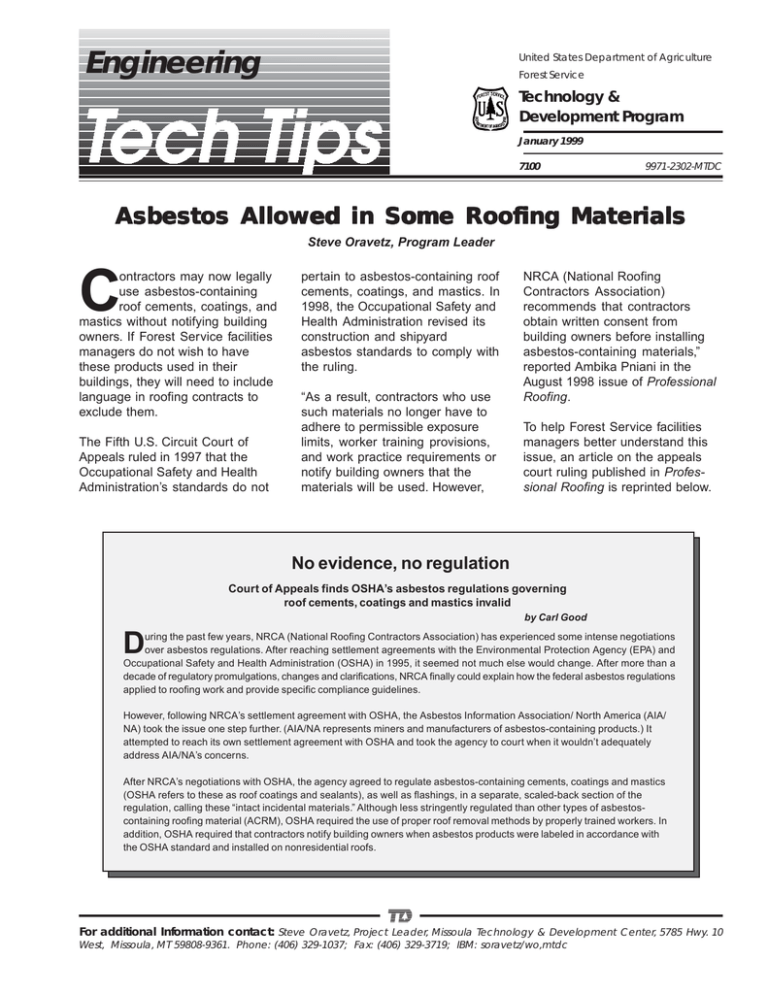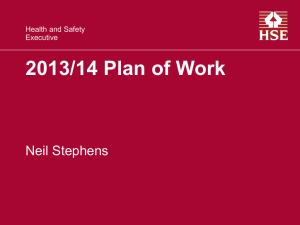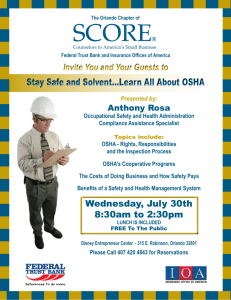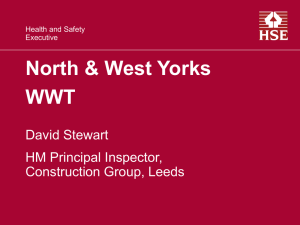Engineering
advertisement

Engineering United States Department of Agriculture Forest Service Technology & Development Program January 1999 7100 9971-2302-MTDC Asbestos Allowed in Some Roofing Materials Steve Oravetz, Program Leader C ontractors may now legally use asbestos-containing roof cements, coatings, and mastics without notifying building owners. If Forest Service facilities managers do not wish to have these products used in their buildings, they will need to include language in roofing contracts to exclude them. The Fifth U.S. Circuit Court of Appeals ruled in 1997 that the Occupational Safety and Health Administration’s standards do not pertain to asbestos-containing roof cements, coatings, and mastics. In 1998, the Occupational Safety and Health Administration revised its construction and shipyard asbestos standards to comply with the ruling. “As a result, contractors who use such materials no longer have to adhere to permissible exposure limits, worker training provisions, and work practice requirements or notify building owners that the materials will be used. However, NRCA (National Roofing Contractors Association) recommends that contractors obtain written consent from building owners before installing asbestos-containing materials,” reported Ambika Pniani in the August 1998 issue of Professional Roofing. To help Forest Service facilities managers better understand this issue, an article on the appeals court ruling published in Professional Roofing is reprinted below. No evidence, no regulation Court of Appeals finds OSHA’s asbestos regulations governing roof cements, coatings and mastics invalid by Carl Good D uring the past few years, NRCA (National Roofing Contractors Association) has experienced some intense negotiations over asbestos regulations. After reaching settlement agreements with the Environmental Protection Agency (EPA) and Occupational Safety and Health Administration (OSHA) in 1995, it seemed not much else would change. After more than a decade of regulatory promulgations, changes and clarifications, NRCA finally could explain how the federal asbestos regulations applied to roofing work and provide specific compliance guidelines. However, following NRCA’s settlement agreement with OSHA, the Asbestos Information Association/ North America (AIA/ NA) took the issue one step further. (AIA/NA represents miners and manufacturers of asbestos-containing products.) It attempted to reach its own settlement agreement with OSHA and took the agency to court when it wouldn’t adequately address AIA/NA’s concerns. After NRCA’s negotiations with OSHA, the agency agreed to regulate asbestos-containing cements, coatings and mastics (OSHA refers to these as roof coatings and sealants), as well as flashings, in a separate, scaled-back section of the regulation, calling these “intact incidental materials.” Although less stringently regulated than other types of asbestoscontaining roofing material (ACRM), OSHA required the use of proper roof removal methods by properly trained workers. In addition, OSHA required that contractors notify building owners when asbestos products were labeled in accordance with the OSHA standard and installed on nonresidential roofs. F T D P For additional Information contact: Steve Oravetz, Project Leader, Missoula Technology & Development Center, 5785 Hwy. 10 West, Missoula, MT 59808-9361. Phone: (406) 329-1037; Fax: (406) 329-3719; IBM: soravetz/wo,mtdc 1 In NRCA’s settlement agreement with EPA, the agency agreed not to regulate these materials when they are nonfriable (i.e., material that, when dry, cannot be crumbled, pulverized or reduced to powder by hand pressure) and handled with hand tools (which is the case a vast majority of the time). The issue of usage—asbestos-containing products vs. asbestos-free—now was one that primarily would be determined by contractor and consumer (i.e., building and home owner) demand and not regulatory concerns. However, some manufacturers already had eliminated their asbestos product lines, primarily because of liability concerns; others continue to offer asbestos-containing products to meet market demand. AlA/NA’s case OSHA never had regulated these products in previous asbestos construction standards because these regulations only became effective if OSHA’s permissible exposure limits (PELs) were met or exceeded. There never has been evidence presented in an asbestos standard rulemaking that indicated PELs could be met or exceeded from handling these products, let alone produce any exposures. The manufacturing process encapsulates the asbestos fibers in asphalt so that they cannot become airborne; also, workers cannot inhale or swallow them inadvertently. In this case, AIA/NA demonstrated that OSHA had imposed regulatory requirements on products without having substantial evidence to prove there is a significant risk to workers who handle them. Appeals court On July 24, the 5th U.S. Circuit Court of Appeals vacated OSHA’s shipyard and construction standards insofar as they regulate asbestos-containing asphalt roof cements, coatings and mastics. The court’s opinion states, “We hold that, because of the lack of substantial evidence in the record, the challenged regulations are invalid as to asbestos-containing asphalt roof coatings and sealants.” As a result of this ruling, the installation, removal, repair and maintenance of asbestos-containing roof cements, coatings and mastics are not regulated by OSHA. In addition, the court’s findings clarified that there is, “no evidence in the record that asbestos fibers can ever escape from roofing sealants and become airborne; in fact, the evidence in that record indicates that they cannot.” Considerations Although in almost all cases asbestos-containing cements, coatings and mastics no longer are regulated, there still are several issues for roofing professionals to consider: 1. Some insurance policies exclude coverage for asbestos-related claims. (This is not the case for workers’ compensation insurance.) Contractors handling any ACRM should make sure they have commercial general liability (CGL) insurance coverage for handling asbestos and understand the extent of the coverage. Most available pollution liability coverage amends only paragraph (1) (d) (i) of the pollution exclusion section of the CGL form. But this amendment only provides contractors (insureds) coverage if the pollutants are brought to the job site by a contractor (or subcontractor), such as when asbestos products are installed on a new roof system. An important precedent was established here—one that NRCA can bring to other rulemaking processes: Without sufficient evidence, a regulation won’t survive. However, if ACRM already is at a job site and a contractor (insured) is removing or repairing it, CGL coverage is excluded by paragraphs (1) (d) (ii) and (2) (a). These paragraphs exclude coverage for bodily injury, property damage and related expenses if the operations are to clean up, remove [or] contain ... pollutants.” Contractors repairing/ removing ACRM need an endorsement that specifically amends these paragraphs. The NRCA-sponsored CNA Insurance Cos., Chicago, Ill., business insurance program offers this endorsement—Roofing Contractors Pollution Liability Coverage Extension G-18042. 2. Contractors must determine whether asbestos is present on a job and if it is to be removed or disturbed. If the only ACRM is cements, coatings and/or mastics, OSHA rules will not apply but EPA rules will if there is a significant quantity (more than 160 square feet [15 m2] of friable material. A contractor should determine friability before handling ACRM. 3. A contract may include language that prohibits installing any asbestos-containing materials. Contractors need to examine contract documents closely for such language and, if it exists, either use asbestos-free products or reach agreement to delete the contract language. In addition, contract documents should include hold-harmless language to limit a contractor’s liability for third-party claims. F T D P 2 Additionally, the deck’s underside always should be examined for asbestos-containing material. Regardless of whether the roofing materials to be removed contain asbestos, typical roofing work may disturb material on the deck’s underside (e.g., asbestos-containing sprayed fireproofing). This material should be removed before roofing work begins. If the building owner does not want to remove the materials, the contractor should include a contract provision stating that the owner is responsible for any claims arising from the owner’s decision not to remove the asbestos materials. Some contractors want to avoid the asbestos issue altogether. However, even if a roofing contractor does not consider handling asbestos-containing materials, he still may be subject to liability if there are asbestos-containing materials he is not aware of on a job and the contract assigns the roofing contractor the responsibility for dealing with them. This is why it is so important for contractors to know if the materials they install, disturb or remove contain asbestos. 4. NRCA previously has recommended that contractors discuss using asbestos-containing products with building owners and obtain their consent (preferably in writing) before installing them. This may minimize the risk that contractors might be sued for money damages or even forced to replace newly installed roofing materials by building owners who discover that asbestos-containing materials have been installed without their knowledge or consent. NRCA is aware of instances in which building owners have brought such suits against roofing contractors. The 5th U.S. Circuit Court of Appeals’ decision reduces the likelihood of such suits in at least two ways. First, by eliminating the previous OSHA requirements applicable to the repair and removal of asbestos-containing roof cements, coatings and mastics, the court’s ruling creates an obstacle to potential claims that installing these products will lead to significantly higher regulatory costs to building owners (e.g., when the materials are removed or repaired). Second, the court’s findings that asbestos fibers are not likely to be released from these products under any foreseeable circumstances undercut allegations that these products present health hazards. Nonetheless, some potential for such suits continues to exist. Even after the court’s decision, building owners still may bring claims based on increased regulatory and other costs, as well as state or local regulations (which can be more stringent than federal requirements). In addition, despite the absence of any rational or scientific basis for fears about health hazards caused by the presence or use of asbestos-containing roof cements, coatings and mastics, some building owners do not want asbestos-containing materials in (or on) their buildings. Accordingly, NRCA continues to recommend, as a matter of prudent business judgment only (i.e., to minimize the potential for litigation, not on account of any federal regulatory requirement), that roofing contractors inform building owners—and obtain their consent in writing, if possible—before installing asbestos-containing products. Contractors who choose to follow this recommendation first should ascertain whether any products they install contain asbestos. This may involve more than just examining the product labeling because some asbestos-containing roof cements, coatings and mastics are not labeled as asbestos-containing. (OSHA’s requirement for a hazard warning on the label of such products does not apply if the manufacturer has “objective data” that show asbestos fibers will not be released under reasonably foreseeable conditions.) Therefore, unless the product labeling states it is asbestos-free, a contractor should contact the manufacturer or distributor to determine whether asbestos is a product ingredient. 5. Contractors should contact landfills and inquire about restrictions and costs for disposing ACRM before submitting a bid or proposal. Even if a particular material is not regulated, a landfill may not accept it. And many landfills that accept ACRM (even when it’s not regulated) will charge a premium for handling it. As a result of this ruling, the installation, removal, repair and maintenance of asbestoscontaining roof cements, coatings and mastics are not regulated by OSHA. 6. To fully implement the court’s ruling, OSHA should amend the asbestos regulation so the “intact incidental” category for certain roofing materials only will include intact flashings. The installation, removal, repair and maintenance of cements, coatings and mastics no longer are regulated by OSHA. A petition is filed OSHA did not appeal the court’s decision, but on Sept. 6, the Building and Construction Trades Department (BCTD) of the AFL-CIO filed a petition for rehearing. It argued that the court ignored material evidence; overlooked the basis on which OSHA developed separate requirements for sealants; and OSHA’s policy decisions are entitled to particularly deferential review and are not susceptible to verification or refutation by the record. At press time, the court had not yet responded to BCTD’s petition, but a rehearing is not expected. F T D P 3 Limited finding The court’s ruling affects only roof cements, coatings and mastics. Although these are the only asbestos-containing roofing products still used in the United States, the regulations for all other types of primary ACRM (e.g., built-up roofing [BUR], flashings, shingles) are not affected by the ruling. Contractors handling ACRM must consider the following: • OSHA regulations always apply whenever ACRM exists, with the exception of asbestos-containing cements, coatings, and mastics. The regulations automatically trigger certain requirements, depending on the material’s nature (i.e., intact incidental vs. intact primary ACRM) and condition (i.e., intact/ nonfriable or nonintact/friable). For more information, roofing professionals should refer to “Federal OSHA and EPA asbestos regulations: The final word,” in the May 1996 issue of Professional Roofing, page 20. • EPA regulates ACRM only in some situations, such as when the material becomes friable or a power roof cutter is used on asbestos-containing BUR felts with a roof area larger than 5,580 square feet (518 m2). • Many States have licensing or certification requirements that are independent of federal regulations. However, OSHA State-plan States have to receive federal OSHA approval to address the roof cements, coatings and mastics issue differently. • Contractors should consult with legal counsel on all matters relating to compliance with OSHA and EPA standards and any other potentially legal requirements/issues. The last chance This was the only remaining legal challenge to OSHA’s revised asbestos standards. However, State and local developments or interpretations may be inconsistent with federal regulations. NRCA will keep Professional Roofing readers informed of these developments and assist whenever possible. An important precedent was established here— one that NRCA can bring to other rulemaking processes: Without sufficient evidence, a regulation won’t survive. Carl Good is publisher of Professional Roofing magazine and NRCA’s associate executive director of member services. Reprinted with permission from Professional Roofing, November 1997: 22-24. Library Card Oravetz, Steve. 1999. Roof cements containing asbestos found legal. Tech Tip 9971-2302. Missoula, MT: U.S. Department of Agriculture, Forest Service, Missoula Technology and Development Center. 4 p. Describes a recent Circuit Court of Appeals ruling that roof cements, coatings, and mastics containing asbestos are legal. Includes by permission a reprint of an article in the November 1997 issue of Professional Roofing explaining the ruling and its implications to roofing contractors. Forest Service facilities managers are affected because contractors are no longer obligated to tell building owners that they are using roof cements, coatings, or mastics containing asbestos. Keywords: buildings, facilities, maintenance, regulations About the Author… Steve Oravetz graduated from the University of Washington in Civil Engineering and is a licensed Professional Civil Engineer. He began his career on the Wenatchee National Forest in 1980. He became Chief Engineer for the Northeastern Research Station in 1993. In 1996, he became Engineering Program Leader at MTDC. Additional single copies of this document may be ordered from: USDA Forest Service Missoula Technology and Development Center 5785 Hwy 10 West Missoula, MT 59808 Phone: (406) 329-3900 Fax: (406) 329-3719 E-mail: wo_mtdc_pubs@fs.fed.us For additional technical information, contact Steve Oravetz at the address above. Phone: (406) 329-3184 E-mail: soravetz@fs.fed.us An electronic copy of this document is available on the Forest Service’s FSWeb intranet at: http://fsweb.mtdc.wo.fs.fed.us/ pubs/htmlpubs/htm99712302/ index.htm F T D P The Forest Service, United States Department of Agriculture, has developed this information for the guidance of its employees, its contractors, and its cooperating Federal and State agencies, and is not responsible for the interpretation or use of this information by anyone except its own employees. The use of trade, firm, or corporation names in this publication is for the information and convenience of the reader, and does not constitute an endorsement by the Department of any 4 product or service to the exclusion of others that may be suitable. The United States Department of Agriculture (USDA), prohibits discrimination in all its programs and activities on the basis of race, color, national origin, sex, religion, age, disability, political beliefs, sexual orientation, or marital or F T family status. (Not all prohibited bases apply to all programs.) D P Persons with disabilities who require alternative means for communication of program information (Braille, large print, audiotape, etc.) should contact USDA’s TARGET Center at (202) 720–2600 (voice and TDD). To file a complaint of discrimination, write: USDA, Director, Office of Civil Rights, Room 326-W, Whitten Building, 1400 Independence Avenue SW, Washington, D.C. 20250-9410, or call (202) 720–5964 (voice and TDD). USDA is an equal opportunity provider and employer.


